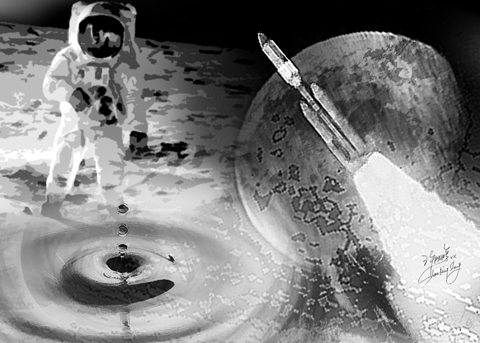NASA’s great lunar fireworks finale fizzled.
After gearing up for the space agency’s much-hyped mission to hurl two spacecraft into the moon, the public turned away from the sky on Friday anything but dazzled. Photos and video of the impact showed little more than a fuzzy white flash.
In social media and live television coverage, many people were disappointed at the lack of spectacle. One person even joked that someone hit the pause button in mission control.

Yet scientists involved in the project were downright gleeful.
Sure, there were no immediate pictures of spewing plumes of lunar dust that could contain water, but, they say, there was something more important — chemical signatures in light waves. That’s the real bonanza, not pictures of geyser-like eruptions of debris, the scientists said.
The mission was executed for “a scientific purpose, not to put on a fireworks display for the public,” said space consultant Alan Stern, a former NASA associate administrator for science.
Scientists said the public expected too much. The public groused as if NASA delivered too little.
The divide was as big as a crater.
“We’ve been brainwashed by Hollywood to expect the money shot, like Deep Impact or when Bruce Willis saves us from a comet,” said physicist and television host Michio Kaku, who was not part of the mission. “Science is not done that way.”
Kaku and other experts, however, also faulted NASA for over hyping the mission, not being honest with the public about the images being a long shot.
“They should have put Steven Spielberg in charge,” Kaku said.
NASA’s LCROSS mission — short for Lunar Crater Observation and Sensing Satellite — had all the makings of a blockbuster. Its main goal was to look for some form of water on the moon — something that could still turn up in those light wave chemical signatures.
A preliminary review of data from the Hubble Space Telescope indicated no signs of water in the debris viewed from the blast, NASA said late on Friday, but added that more study was needed.
Water on the moon could change NASA’s troubled plans for space exploration. It would make revisiting and putting a base on the moon far cheaper because the moon’s water could be used, Kaku said.
It was relatively cheap and last-minute by NASA standards. Just US$79 million, in about three years. It was elegant in its simplicity.
An empty rocket hull that would normally be space junk remained attached to the plucky little LCROSS until pulling away on Thursday night. On Friday morning, it smashed into a crater near the moon’s south pole.
Then the little satellite flew through what was supposed to be a 9.6km plume of dust from the crash, taking pictures and measuring all sorts of stuff, mostly looking for water.
Moments after the first crash, the smaller spacecraft itself hit the moon for a second impact.
The crashes created a man-made crater about one-fifth the size of a football field, Brown University geologist and LCROSS scientist Peter Schultz said.
It all worked perfectly, according to NASA. But there were no pictures of a plume. There may not have been a plume at all, or maybe it was just hidden or too small, said LCROSS scientist Anthony Colaprete.
The spacecraft, instead of spewing 9.6km of dust straight out, could have compacted the lunar soil — sort of like a rock sinking quickly in water instead of making a massive splash.
“We saw a crater; we saw a flash, so something had to happen in between,” Colaprete said.
The crater was the aftermath of the crash, and the flash was the impact itself.
The key is not in photographs, but in squiggly lines that show those complicated light waves, Colaprete said. Once they are analyzed — a task that may take weeks — the light waves will show whether water was present at the crash site.
“It wasn’t a dud. We got a gold mine of data,” said Kaku, a professor at the City College of New York and host of Sci Q Sundays on the Science Channel.
If those squiggly lines show there is ice just under the surface of the moon, it would make the lack of pictures worth it, he said.
“Ice is more valuable than gold on the moon,” Kaku said.
For about a decade, scientists have speculated about buried ice below the moon’s poles. Then surprising new research last month indicated that there seem to be tiny amounts of water mixed into the lunar soil all over the moon, making the moon once again a more interesting target for scientists.
A discovery of ice later this month, however, would not be quite the same as seeing the promised flashes through a telescope.
People who got up before dawn to look for the crash at Los Angeles’ Griffith Observatory threw confused looks at each other instead. They tried to watch on TV because the skies were not clear enough, but that proved disappointing too.
Telescope demonstrator Jim Mahon called the celestial show “anticlimactic.”
“I was hoping we’d see a flash or a flare, evidence of a plume,” he said.
The saga of Sarah Dzafce, the disgraced former Miss Finland, is far more significant than a mere beauty pageant controversy. It serves as a potent and painful contemporary lesson in global cultural ethics and the absolute necessity of racial respect. Her public career was instantly pulverized not by a lapse in judgement, but by a deliberate act of racial hostility, the flames of which swiftly encircled the globe. The offensive action was simple, yet profoundly provocative: a 15-second video in which Dzafce performed the infamous “slanted eyes” gesture — a crude, historically loaded caricature of East Asian features used in Western

Is a new foreign partner for Taiwan emerging in the Middle East? Last week, Taiwanese media reported that Deputy Minister of Foreign Affairs Francois Wu (吳志中) secretly visited Israel, a country with whom Taiwan has long shared unofficial relations but which has approached those relations cautiously. In the wake of China’s implicit but clear support for Hamas and Iran in the wake of the October 2023 assault on Israel, Jerusalem’s calculus may be changing. Both small countries facing literal existential threats, Israel and Taiwan have much to gain from closer ties. In his recent op-ed for the Washington Post, President William
A stabbing attack inside and near two busy Taipei MRT stations on Friday evening shocked the nation and made headlines in many foreign and local news media, as such indiscriminate attacks are rare in Taiwan. Four people died, including the 27-year-old suspect, and 11 people sustained injuries. At Taipei Main Station, the suspect threw smoke grenades near two exits and fatally stabbed one person who tried to stop him. He later made his way to Eslite Spectrum Nanxi department store near Zhongshan MRT Station, where he threw more smoke grenades and fatally stabbed a person on a scooter by the roadside.
Taiwan-India relations appear to have been put on the back burner this year, including on Taiwan’s side. Geopolitical pressures have compelled both countries to recalibrate their priorities, even as their core security challenges remain unchanged. However, what is striking is the visible decline in the attention India once received from Taiwan. The absence of the annual Diwali celebrations for the Indian community and the lack of a commemoration marking the 30-year anniversary of the representative offices, the India Taipei Association and the Taipei Economic and Cultural Center, speak volumes and raise serious questions about whether Taiwan still has a coherent India